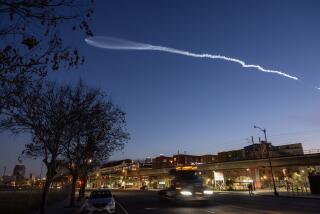Governor and Others Still Hold Out Hope
Gov. George Deukmejian and others who have worked to lure the super collider to California said Tuesday they still hope to capture the project, even though the state is not among eight recommended finalists.
They restated their commitment after learning that the National Academy of Sciences chose not to include California among the states recommended to the federal Department of Energy as potential sites for the proposed atom-smasher project.
â(The Department of Energy) tells us this is an unofficial list and now goes under review by the department and could change,â said Rick Malaspina, spokesman for the state Collider Commission, the gubernatorial body that wrote the stateâs bid. âWe still want to know why weâre not on it, and whether we can get on it now.â
âWe continue to believe that either of Californiaâs two sites would be an excellent location for the (super collider),â said William B. Baker, chairman of the Collider Commissionâs executive steering committee, âand we hope that the Department of Energy will closely examine Californiaâs advantages as it prepares the final list of best-qualified sites.â
Deukmejian said he might try to revive efforts to lure the project, which would employ 10,000 during construction and create 2,500 permanent jobs, to one of two 16,000-acre sites in the Central Valley. That would require the Energy Department to override the academyâs recommendation and summarily add California to the list of finalists.
Opponents Uncertain
Similar uncertainty was expressed by farmers and other Californians who opposed the proposed $4.4-billion federal project on environmental grounds.
âItâs a little premature for celebration, because this was only Round 1,â said Richard Harriman, a Modesto lawyer representing those opposed to siting the collider in California. âThis is another nail in the coffin (of Californiaâs bid), but it doesnât kill it. Thereâs just too much political juice being applied over this thing.â
The Energy Department is expected to issue its confirmed list of finalists as early as Monday. The âpreferredâ site is scheduled to be made public in July. Twenty-five states nominated 35 different sites when the bidding closed last August.
Deukmejian, who made the collider a pet project and lobbied heavily for it, said he was âvery disappointedâ that California was not among the finalists. The state had nominated two rural sites, one east of Stockton and the other west of Sacramento.
Pursuing Explanation
He said he spoke to Energy Secretary John S. Herrington and asked him to âpursue an explanation for Californiaâs omission from the list.â
âIf a reason is provided,â the governor added, âwe will certainly take all appropriate steps to remedy any difficulty.â
Gubernatorial press secretary Kevin Brett said a statement from the academy seemed to imply that âseismic and geologic considerations may have come into playâ in selecting finalist states. However, no individual state was cited as having failed to qualify for seismic or geologic reasons.
Brett said it was distressing that the state was left off the list because âCalifornia long has been regarded as a leader in high technology.â
Indeed, California was considered a leading collider candidate for several reasons, not the least of which was the number of Californians involved in the selection process. Six of the 21 members of National Academy of Sciences panel are from the state, including its chairman. At the same time, both Herrington and President Reagan are Californians--facts that Deukmejian noted in meetings and letters with the two men.
Top Research State
In addition, California is among the top states for research, especially in the field of high-energy physics. The very first high-energy atom smasher was invented at the University of California in Berkeley, which still houses many cutting-edge physics projects. Meanwhile, Stanford University researchers are pioneering a âlinear colliderâ that some scientists believe may be the model for the next generation of even higher-energy atom smashers.
These facilities also mean California has an established corps of builders and technicians capable of maintaining, operating and repairing sophisticated scientific equipment.
California also wooed the collider with huge financial incentives. The $560-million package included such things as free land and buildings and subsidized utilities and transportation.
However, California also had several negative factors to contend with.
One was the perception that the state already has more than its fair share of federally funded research facilities.
Fear of Quakes
Another was the persistent fear of earthquakes. California officials tried to counter this by choosing sites with no known active faults.
California also was hurt by the farmers and others who fought the collider for several reasons--because it threatened to take top agricultural land out of production, foster urban growth in rural areas, consume scarce water and pose some potential environmental problems.
Michigan farmers, though not as loud or well organized as their California colleagues, have voiced similar concerns, but apparently without crippling that stateâs bid for the project.
More to Read
Sign up for Essential California
The most important California stories and recommendations in your inbox every morning.
You may occasionally receive promotional content from the Los Angeles Times.










